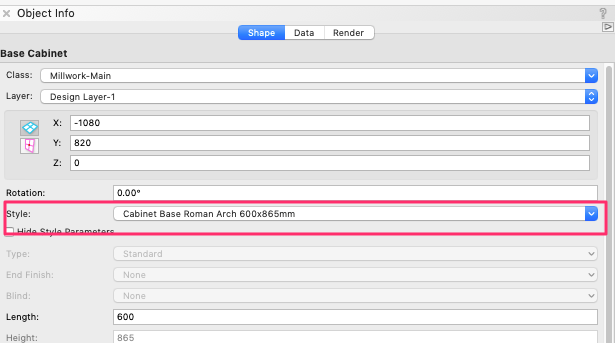-
Posts
142 -
Joined
-
Last visited
Content Type
Profiles
Forums
Events
Articles
Marionette
Store
Everything posted by ColinW
-
Yes, I've seen the same behaviour. A bug has been submitted.
-
Dave, file attachedtest render model.vwx
-
8:11, AMD Risen 7 7700, 64Gb Ram, RTX 3070 OC 8Gb, Windows 11 (£1,520 in 2023) 27.20, MacPro 2013 12 Core, 32Gb MacOS 12.6.4 (£4,000 in 2014)
-

Offsetting the rim from the jamb to make room for hinge in BIM.
ColinW replied to Meret's topic in Architecture
Windoor allows control of the architrave offset if you have access to it. -
PDF Squeezer on MacOS has been my go for years, it’s easy , quick and controllable. Oh, and good value.
-

Brick header and decorative window lintels
ColinW replied to Christiaan's question in Wishlist - Feature and Content Requests
That’s disappointing, the Graphic Legends feature shows great promise -

Brick header and decorative window lintels
ColinW replied to Christiaan's question in Wishlist - Feature and Content Requests
The most straight forward work around is to use Windoor which allows more control of this. I do wonder what led to the 2 dimensions being one parameter, is this a ‘normal’ thing somewhere? -
Quite!
-
Emily, Thats right, it's line control is just out of reach for now! good luck with your custom window symbol. Regards Colin
-
It seems to use the None class, and as you noticed, doesn't appear as an option in the Window/Settings/2D visualization tab. If you don't already know, if you ever need to check these you can set up a test PIO and assign seperate classes to each category in the 2d visualization tab, then select and press Command+K, it will be converted to a group so you can then check which classes have been assigned to each part. Some groups will have a class from the visibility section of the same 2D visualization tab, so the sash swing is in a group by default in the visibility class 'Sills', but inside that group the swept arc of the sash is defined by the 'Swing' and is configured to use the class fill and line; the dotted rectangle showing the sash projection uses the 'None' class, but it's line and fill do not use the None class settings so it is preset as far as I can tell. Hope this helps (!), it's not very intuitive and the naming of the visibility classes is certainly misleading.
-

BS1192/ISO19650 compatible Class Libraries - Update
ColinW replied to shorter's topic in General Discussion
It is surprising, I have found them really helpful. Thank you! -
If the window is controlled by a style, right click on the symbol defining the style in the resource browser, you will see the plug- in object options in the context menu. if it is unstyled, right click on the window PIO to get the same menu.
-

What specifications software systems are you using?
ColinW replied to LDraminski's topic in Architecture
Like Christiaan, I used to use NBS Building, that has now been replaced with Chorus which is too expensive for a couple of months use per year. The small version of Chorus doesn't use Uniclass and is too restricted for the work we get involved in, the medium and large scale versions are difficult to justify the costs for limited use. So now when we do write specifications, it is manual office standards. -

Additional Roof Options
ColinW replied to Kevin K's question in Wishlist - Feature and Content Requests
I usually model ridge tiles, the roof looks more realistic and of course they show in hidden line elevations and roof plans too. In areas with tight planning controls, visually appealing, accurate representations really help to sway the doubters. We have solar panels, surely ridge tiles can’t be too difficult. Space X, now that’s difficult! -

A quick Question to all architects regarding windows dimensions
ColinW replied to FBernardo's topic in Architecture
It excludes the sill which isn’t always what you might wish for. The worksheet can be modified so the reported height is a sum of the window frame height plus the sill height. -
Data visualisation is another good option if it is available in your version of VW, it can avoid creating variations of classes to control visibility. If you haven't used it already, it really is worth becoming familiar with it.
-

BS1192/ISO19650 compatible Class Libraries - Update
ColinW replied to shorter's topic in General Discussion
Thanks Steven, excellent work! -

Additional Window Options
ColinW replied to Kevin K's question in Wishlist - Feature and Content Requests
I'm a Windoor user in the UK but signed up before the 'Windoor' closed!. It's a long time ago but I think it was proving too time consuming to support all the different requirements from around the globe. Whilst I like Windoor and use it almost exclusively, the answer rests with improvements to the window and door pios which are born out of a realistic and deeper undertsanding of the functionality required. -

Doors with built-in ADA clearance + approach boxes
ColinW replied to Tom Klaber's question in Wishlist - Feature and Content Requests
This would be a very useful addition. OzCAD's Windoor PIO has similar functionality for the Aus and NZ markets so it should be acheivable with the built in Door PIO given the recognition that this an everyday requirement to comply with mobility access standards. No doubt the dimensions will vary around the world so control for localisation will be essential, similar to the stair PIO. -
Cinema4d has been marginally more consistent than fbx but both work well in most situations
-
Ask the designer to export their file from VW into a dwg version compatible with your AutoCad version. VW can export to most dwg versions. It’s useful if they supply a pdf version of the file so you have a visual reference in case there are are any obvious issues with the exported file.
-

Best Practices for Casework + Interior Components
ColinW replied to e_calabrese's topic in Architecture
If you've used the resource content they are probably assigned to a style, see image attached. If this is the case then to adjust the parameters which are greyed out in the information palette just select none in the style drop-down menu, that should allow you to adjust the other parameters. If you then want a new family of sizes based on this you can save it as a new style but don't set the variable parameters. to use the new style, just the elements you wish to be fixed. -
My 2020 installation doesn't have the Classic RAL Colours, it does list the Classic RAL Bonn 2019 version immediately below that on your screenshot. Wonder if it's and older palette? Screenshot 2019-09-24 at 14.10.02.pdf
-
The actual opening dimensions also need to account for and extra mortar joint so it's not a pure module dimension either.
-
The installers are fragmented so the process isn't as straight forward as it should be although I didn't have any issues (on a mac), I've previously had a large format Canon so that may have helped.



